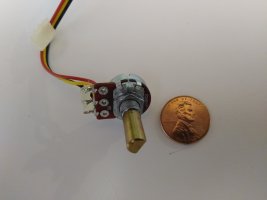Watching the actual response (red/green bars on screen), the new pots look much smoother than the Logitech ones. Does that mean better resolution? I know its only a visual but thats how it seems. It could also just be that the Logitech pots are jittery from being old and dirty.
Yeah, not being old and dirty is probably a massive win here. The resolution thing isn't trivial to detect with the naked eye, depending on the length (in pixels) of the bar. An expensive pedal might claim 12- to 16-bit resolution, and thus deliver thousands of distinct values over the full pedal range, but even then, I'm not certain you could readily tell that apart from a pedal that only delivers 40 or 50 distinct values (as I'm guessing yours now may do), if you use something like the Assetto Corsa throttle bar to check them.
I have 3 sets of logitech pedals I looked at. One each from a g25, g27, and g29. Each pot from the pedals are 300 degrees, same as the replacements. When they are assembled, they only use about 70 degrees of the 300 available.
So, just to clarify what I was getting at: the original pots do have quite a lot of
mechanical rotation (I can't recall, but maybe as much as 300 degrees) but they deliver their full output resistance/voltage swing over a very small angle - nominally just 70 degrees. This is why I'm estimating that you'll suffer when using a normal 300 degree pot.
See below for pics of the exterior of an original pot ("10K/70" is the crucial text) and the carbon track inside a disassembled one. You can see that the contact point wear lines scored into the carbon track have a pretty restricted angular extent, of roughly 60 degrees (even though the track itself extends over roughly 180 degrees).
You can also just about make out the key "unusual" thing about the pots - the metal track continues a long way
underneath the carbon on both sides of the worn patch. This I imagine is how the pot generates the full swing over a restricted angular range. Thinking about it now, it may actually be possible to retrofit an existing pot with some kind of extra metal/conductive strip to short out the first and last portions of the carbon track, and amplify the resistance/voltage swing per unit angle over the remainder...
(FWIW, I eventually stopped using the 3DRap kit, reinstalled the original pots, and swapped to cheap and cheerful DIY Hall sensors developed with
@GeekyDeaks - see
here for dev thread and
here for a (reasonably!) polished end-result.)










